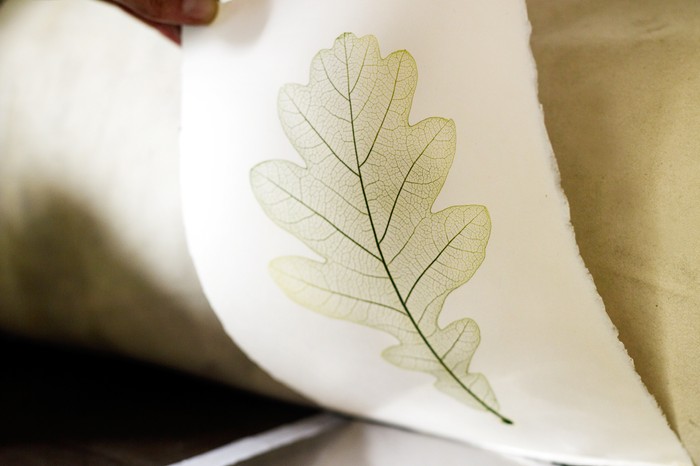
Pia Östlund and the art of nature printing
Designer and printmaker Pia Östlund has reinvented the lost craft of nature printing and now creates beautiful works of art. Words Rosanna Morris, Photographs Andrew Montgomery
We spoke to Pia about her nature printing in 2015, here is the article from our archives.
Nature in Print
In a light studio in Hackney, graphic designer Pia Östlund is turning the wheel of a mangle rolling press. When the print bed has passed through the rollers, she lifts off six layers of blankets to reveal a piece of paper attached to a copper plate. Ever so gently, Pia peels the paper off the plate and turns it over. In her hands she holds a beautiful print of a giant oak leaf – a deep, verdant green that highlights the leaf’s veins and midrib, which are slightly raised. While it has taken Pia five minutes to produce this print, it has taken her five years to reach this point. What has just rolled off the press is a nature print – a highly detailed, life-size print of a plant made using a method that had become obsolete. That is, until Pia saw a book at the Chelsea Physic Garden.

Pia has worked freelance for the garden since 2001, creating signage and merchandising, often using the garden’s library of rare books for sourcing image material. One day, among rows of old herbals and engraved botanical works, she spied a hefty tome entitled The Ferns of Great Britain and Ireland by Thomas Moore (curator at the garden from 1848 to 1887), with pages displaying life-like and life-size images of ferns in colour. “They were too detailed to be drawn by hand but they certainly weren’t photographs,” says Pia. “I could feel the raised texture of the plants but the colour was too intense to be an actual pressed and dried specimen.” Puzzled, Pia noticed two words in the left-hand corner of the page: ‘nature printing’. Having moved from Sweden to London to study graphic design at Central St Martins, Pia was familiar with printing techniques but she still couldn’t see how these had been executed.

With her curiosity piqued, she started researching. “I first thought I could Google ‘nature printing’ but there was nothing out there,” says Pia. She eventually discovered that, while nature printing began simply as a method of inking up a leaf and taking an impression on paper (widely used by physicians to make plant records in the 15th century), during the 19th century a new form of nature printing was developed as new technologies enabled the production of printing plates.

Through endless enquiries and searches, Pia finally found all the pieces to the puzzle. A dried plant specimen was pressed into a sheet of lead and this impression was then copied using electroforming (suspending the piece of lead in an acid bath and, using an electric current, growing a layer of copper on it) to produce a copper printing plate. Numerous prints of the plant could be made. But the craft died out by 1900 – it was too costly and lithography took its place.

Pia has since taught herself the process of making the plates and has recently produced her own in her Hackney studio, which means she can now print as many giant oak leaves as she wishes and put together editions. She has also gone to great lengths to perfect her technique; working out the correct paper and inks, the extent to which she applies and wipes off the inking on the plate – even the number of blankets on the press. “I can see that the prints I’m making have the same quality as they had then,” says Pia. “I love how the physicality of the plant is transferred into the plate and the print is more like an X-ray. I also love that you can send a plate through the press and find this curious image at the other end.”
You can find out more about Pia's work and what she is doing now on her Instagram page.

Niwaki bundle worth £57 when you subscribe
Subscribe to Gardens Illustrated magazine and claim your Niwaki bundle worth £57
*UK only

Container Gardening Special Edition
The Gardens Illustrated Guide to Container Gardening.
In this special edition, discover colourful flower combinations and seasonal planting schemes for pots designed by leading plantspeople, and essential know-how for container gardening success. Just £9.99 inc UK p&pBy entering your details, you are agreeing to our terms and conditions and privacy policy. You can unsubscribe at any time.

Gardens of the Globe
From botanical wonders in Australia to tranquil havens closer to home in Ireland, let this guide help you to discover some of the most glorious gardens around the world
By entering your details, you are agreeing to our terms and conditions and privacy policy. You can unsubscribe at any time.




